Iranian sanctions approaching crude oil or turning around
I. Analysis of the spot market of crude oil
OPEC agreed to increase crude oil supply as early as June to compensate for the expected disruption of Iranian exports, but the increase in Saudi Arabia's supply was offset by declines in other regions. At the same time, relevant data indicates that crude oil demand is expected to be poor next year. International trade disputes are likely to drag down the economic growth of various economies, thus affecting the demand for crude oil. In addition, there is news that Saudi Arabia is committed to further increase production, and the recent decline in the stock market has put pressure on risk assets, crude oil has been hit, and the market's concerns about the situation in the Middle East have failed to support oil prices, and short-term international oil prices are weak.

Figure 1: WTI, Brent crude oil price chart (USD / barrel)
Source: Huishang Futures Institute WIND
From the trend of the disk, as of October 24, Brent December crude oil futures reported the latest 76.46 US dollars per barrel rose 0.02 US dollars to trade 4435 hands, in January reported 76.27 US dollars per barrel rose 0.12 US dollars to 3025 hands. WTI December crude oil futures reported a decrease of US$66.38 per barrel and US$0.05 for a turnover of US$20,183. In January, it reported a loss of US$66.55 per barrel of US$0.07. International crude oil prices have risen from the beginning of the month to the recent plunge, and there are many uncertainties in the market. At present, the oil loss is less than that of US oil. The Brent-WTI spread has been extended from US$9.0/barrel to US$10.7/barrel. The Brent-WTI spread has continued to expand. The Brent-SC spread is relatively large, the spread is positive and negative, and the RMB depreciation and other factors have attracted much attention from the market.
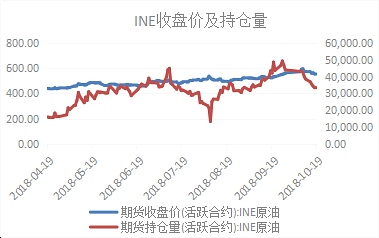
Figure 2: INE crude oil closing price and position trend
Source: Huishang Futures Institute WIND
In the spot market, OPEC has struggled to increase production since June, as Saudi production growth was offset by declines in production in Iran, Venezuela and Angola. Saudi Energy Minister Falih pointed out that OPEC and non-OPEC oil producers agreed to increase production by 1 million barrels per day at the June meeting, but the latest data shows that the current increase in production has not yet been fully implemented. In the Asian crude oil market, oil prices are currently rising and falling, and the price difference between condensate and ultra-light crude oil is declining, but the price difference between crude oils rich in medium-distilled oil is expected to rise. Recently, the international crude oil market has been interspersed with long and short news, but in the middle and late October, the bearish factor has dominated the market, and the international oil price has shown a broad downward trend.
US sanctions against Iran are approaching. South Korea’s state-owned oil company (KNOC) released data on Tuesday, showing that Iran’s Iranian crude oil imports fell to zero in September, and total crude oil imports fell 14.4% year-on-year to 79.7 million barrels. China's diesel and gasoline exports in September fell sharply from August, as domestic demand boosted exports. In addition, according to news from Jinlian, the spot of crude oil in the Middle East is being sold at the discounted price in the Asian market. Therefore, the former OPEC oil producers increased their supply to replace Iranian crude oil, and the natural disaster caused the demand from Japan to decrease.
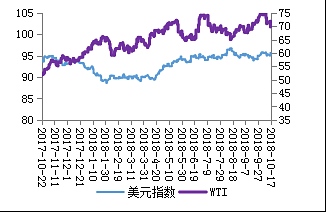
Figure 3: The relationship between the US dollar index and crude oil
Source: Huishang Futures Institute Wind
The latest US CPI in September was lower than expected, and the rise in the number of unemployed people has put the dollar under pressure. Subsequently, the US import price index in September was higher than expected and the previous value, which boosted the US dollar index and the US dollar index rebounded slightly. In mid-October, the US dollar index was affected by the Fed’s interest rate hike, and the US dollar index fluctuated above the 95 mark. Recently, due to the significant deterioration of the US stock market sentiment, insufficient support for the US dollar, and the US retail sales fell short of expectations, once again, the dollar fell under pressure and boosted crude oil.
Second, crude oil supply and demand situation
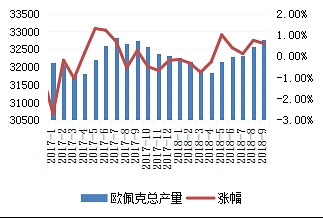
Figure 4: Changes in OPEC crude oil production
Source: Huishang Futures Research Institute Baichuan Information According to the October monthly crude oil market report released by the Organization of Petroleum Exporting Countries (OPEC), crude oil production recorded an overall increase. Among them, Saudi Arabia's production increased by 108,000 barrels per day to 10.512 million barrels per day, becoming the main force of OPEC production. Iran’s output fell by 150,000 barrels per day to 3.447 million barrels per day due to the sharp decline in crude oil exports. Iran’s crude oil production has recorded a four-month decline (376,000 barrels per day), and the decline is still expanding. . As one of the world's major oil producers, Venezuela has experienced a severe economic crisis in the country, causing a sharp decline in crude oil production, which has fallen to its lowest level in 40 years. On the whole, OPEC crude oil production in September increased by 132,000 barrels per day to 32.761 million barrels per day, the highest since August 2017.
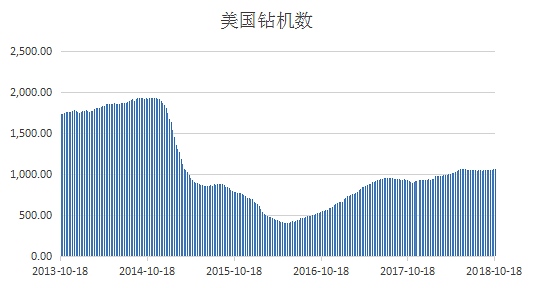
Figure 5: Number of US oil rigs
Source: Huishang Futures Research Institute Jinlian
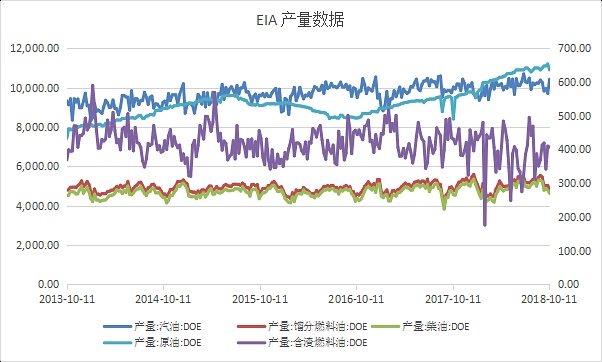
Figure 6: EIA crude oil production report
Source: Huishang Futures Institute Wind
In addition, US oil service company Baker Hughes announced on October 19 that as of the week of October 12, the number of active oil drilling in the United States increased by 8 to 869, the first time in four weeks, the growth was recorded in mid-August. The largest single-week increase since then. The total number of active oil and gas drilling in the United States increased by 11 to 1063. As of the week of October 12, the daily output of US crude oil decreased by 300,000 barrels to 10.9 million barrels, an increase of 14.83% compared with the beginning of the year, and the initial value was 99.2 thousand barrels per day.
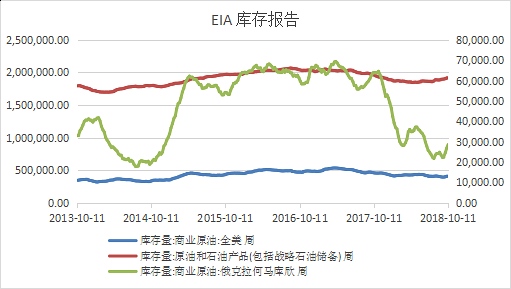
Figure 7: US crude oil inventories
Source: Huishang Futures Research Institute Jinlian
US crude oil exports fell, US crude oil imports increased, and crude oil inventories increased. According to the US Energy Information Administration, US crude oil inventories reached 416.41 million barrels in the week ending October 12, 2018, an increase of 6.49 million barrels from the previous week. The total amount of US commercial oil inventories increased by 2.99 million barrels. The average processing volume of refineries in the United States averaged 16.316 million barrels per day, an increase of 77,000 barrels compared with the previous week. The operating rate of refineries was 88.8%, down by 0.0 percentage points from the previous week. Crude oil in the Cushing area of ​​Oklahoma, USA, was 28.628 million barrels, an increase of 1.776 million barrels.
Overall, the EIA report showed a significant increase in crude oil inventories and production, and the number of active oil drillings in the United States increased, and the supply side was short of crude oil.
Thin film transistor liquid crystal display, commonly referred to as the TFT-LCD, is a type of liquid crystal display that USES thin-film transistor technology to improve the image quality. Although TFT-LCD is collectively known as LCD, it is an active matrix LCD used in televisions, flat screens and projectors.
Simply put, the TFT-LCD Panel can be seen as a layer of liquid crystal sandwiched between two glass substrates, the upper glass substrates being color filters, and the lower glass having transistors embedded in it. When the current passes through the transistor, the electric field changes and the liquid crystal molecules deflect, so as to change the polarization of the light, and then the polarizer is used to determine the light and dark state of the pixel. In addition, the upper glass is fitted to the color filter, so that each pixel contains three colors of red, blue and green, which make up the video image on the panel.
The Thin film Liquid Crystal Display is a type of most liquid crystal display that USES thin-film transistor technology to improve the image quality. Although TFT-LCD is generally referred to as LCD, it is an active matrix LCD. It is used in TV, flat panel display and projector.
I2C Tft Display,4.3 Inch Display,Lcd 4.3 Inch,Arduino 3.5 Tft Lcd
Tonya Display Limited , https://www.tydisplay.com